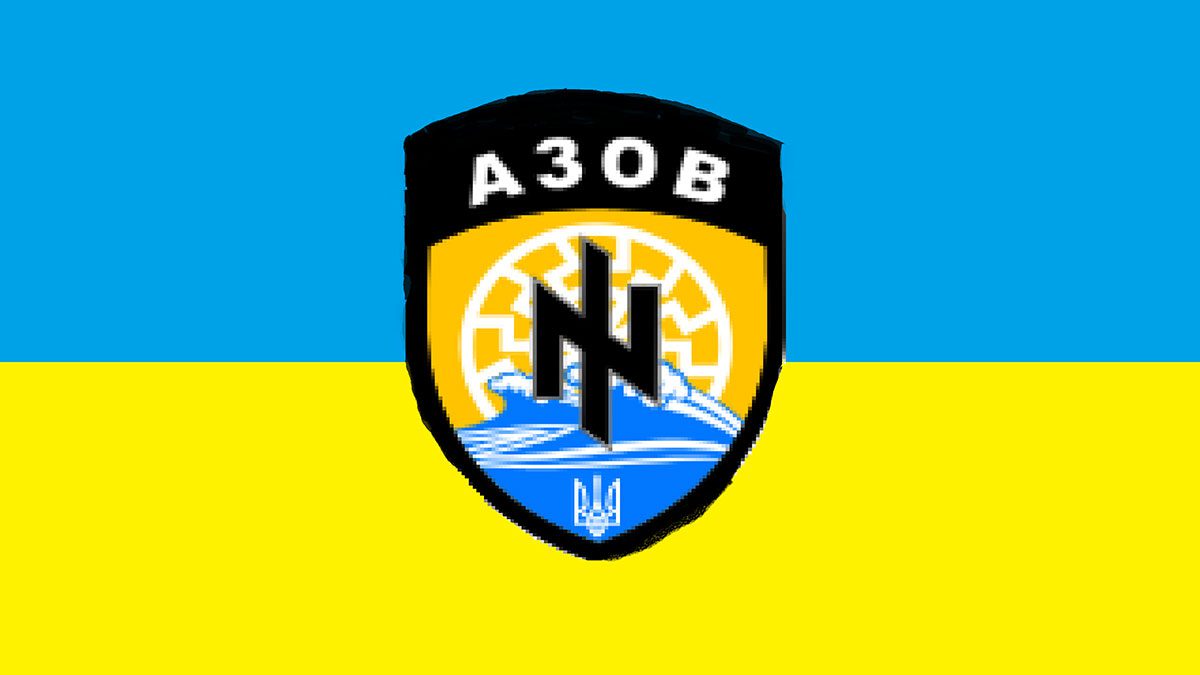Illustration — Flag of the Azov Regiment
Inside the coat of arms: the Wolf’s Hook, superimposed upon the waves of the Sea of Azov. The white circle represents the Black Sun. The Wolf’s Hook and the Black Sun are classical Nazi symbols. In the background: the blue and yellow of the Ukrainian flag.
Radical nationalists, including fascists and Nazis, play a significant role in the war in Ukraine and an even more significant role in the propaganda war. Putin justifies his attack on Ukraine as a crusade to ‘de-Nazify’ the country, while some pro-Ukrainian propagandists describe the Putin regime as fascist.[1]
In a recent book,[2] journalist Michael Colborne sorts truth out from lies and myths concerning the Azov Movement, in recent years the most salient structure on the Ukrainian nationalist right. The movement originated as a military formation — a battalion, then a regiment fighting pro-Russian forces in the Donbas – but has evolved into a multifaceted complex, encompassing a political party (the National Corps), social centers, sports and youth clubs, military training camps, special projects, and publishing houses.
Writers seeking to play down the importance of the radical right in Ukraine point out that Azov – like its predecessors, Right Sector and the Freedom Party – has done very poorly in elections. If Ukraine were a stable democracy at peace, that might be a clinching argument. But it is not. Several factors give Azov influence out of all proportion to its electoral weight. The ethos of wartime national unity and the reputation of Azov men as brave fighters shield the movement from criticism, while the patronage of some oligarchs and government ministers provides access to resources and facilitates the use and threat of violence to intimidate opponents.
Under conditions of peace, Azov and other ultra-nationalist groups would soon be relegated to the margins of Ukrainian politics. It is a product of war and flourishes in war. However many men Azov may have lost in the defense of Mariupol, I expect it will soon replenish its ranks. If Putin is really invading Ukraine for the purpose of de-Nazification, which is doubtful, he could hardly have chosen any more counterproductive way of doing so.
The Russian radical right has also taken an active part in the war, providing many of the volunteers who have gone to fight in the Donbas since 2014. Although the Putin regime has harassed or banned some Russian nationalist groups, it has collaborated with others, depending to a large extent on the attitude taken by the groups themselves toward the regime. Thus, Alexander Dugin and Eduard Limonov, former co-leaders of the National Bolshevik Party, went separate ways: Dugin demonstrated loyalty to Putin and acquired influence within the regime, while Limonov took the path of opposition. According to Colborne, the Combat Organization of Russian Nationalists is one of the groups close to the Kremlin, on whose behalf it has committed at least ten murders, including those of human rights lawyer Stanislav Markelov and journalist Anastasia Baburova in 2009.
In their mutual accusations of Nazism and fascism, both sides are ‘pots calling the kettle black.’
Remarkably, quite a few radical Russian nationalists opposed to Putin have chosen to defect to Ukraine. It is estimated that 3,000 of the volunteers fighting on the Ukrainian side come from Russia. Several men who used to be prominent on Russia’s far right – for example, Alexei Levkin, founder of the Hitlerite cult Wotanjugend – have been granted Ukrainian citizenship and are now associated with the Azov Movement. Olena Semenyaka, international secretary of the National Corps and an Azov ideologist, used to belong to Dugin’s Eurasianist Movement (though she was born and grew up in Ukraine).
Russian and Ukrainian radical nationalists compete for the same niche in world politics, as the center of resistance to recent developments in the West that they perceive as ‘decadent’ – ideas of human and especially minority rights, multiculturalism and multiracialism, tolerance of homosexuality, non-Christian religions, and even atheism, women’s liberation, rejection of sex roles, etc. Ukrainian and most Russian nationalists believe in ‘Europe’ – not, however, today’s Europe but the Europe of yesteryear, when Europe was unambiguously ‘white’ and ‘Christian.’
Nevertheless, neither Russia nor Ukraine are ideally placed to fill this niche. Russia is still a multi-ethnic and multi-confessional state – neither ‘white’ nor ‘Christian’ enough for purists. This is what gives the alternative ‘Eurasianist’ identity a certain appeal in Russia. In Ukraine – and also in some other countries of the Central-East European region, like Poland and Hungary – the old Europe is still preserved intact. ‘The heart of Europe beats in the East.’ And yet geopolitically Ukraine is allied with and wholly dependent on the ‘decadent’ Europe of the West. The fight with Russia is the top priority, but later Ukraine will have to disentangle itself from – unless it can help to revive — this ‘decadent’ Europe.[3]
The European radical right nowadays believes in a united though not homogenized Europe, as conceived by thinkers of the French New Right. ‘No more brother wars!’ is a popular slogan. And yet Russian and Ukrainian fighters in the current war find themselves trapped in just such a ‘brother war’!
Notes
[1] See: Alexander J. Motyl, ‘Putin’s Russia as a fascist political system,’ Communist and Post-Communist Studies (2016), 49 (1), 25-36. Professor Motyl recently reaffirmed his view: ‘Alexander Motyl: Yes, Putin and Russia are fascist. How they meet the textbook definition,’ The Conversation, March 31, 2022. For opposing assessments, see: Marlene Laruelle, Is Russia Fascist?: Unraveling Propaganda East and West (Cornell University Press, 2021); Andreas Umland, ‘Is Putin’s Russia Really “Fascist”? A Response to Alexander Motyl’.
[2] From the Fires of War: Ukraine’s Azov Movement and the Global Far Right (Stuttgart: ibidem-Verlag, 2022).
[3] See interview with Michael Colborne, March 29, 2022.



